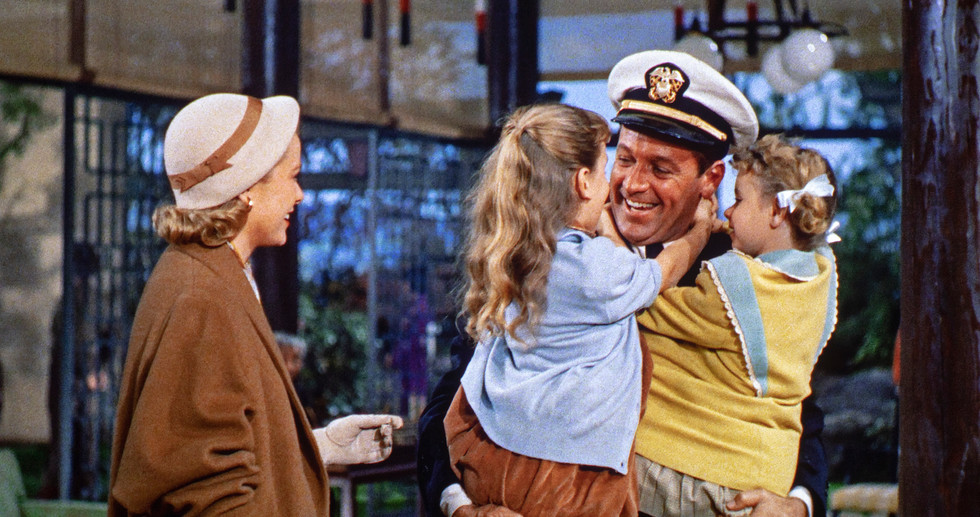A war story for adults – “The Bridges at Toko-Ri”
- Mike Reynolds
- Jul 8, 2023
- 5 min read
BLU-RAY REVIEW / FRAME SHOTS
William Holden plays Lieutenant Harry Brubaker, a former WWII Navy pilot reactivated for the Korean conflict onboard the USS Savo Island. Grace Kelly plays Harry’s wife Nancy, and they say their goodbyes after a five-day leave.
(Click an image to scroll the larger versions)
“THE BRIDGES AT TOKO-RI”
Blu-ray; 1954; Not Rated, contains war violence
Best extra: Audio commentary with film historian Steve Mitchell and author/historian Steven Jay Rubin (author of "Combat Films: American Realism.)
BIG PROJECTS done quickly aren’t usually done well.
The exception to that rule is “The Bridges at Toko-Ri.”
Adapted from James Michener’s short novel of 1953, “Bridges” took a little over two months to film and was released in 1954. He got his story as an embedded reporter on the USS Essex, an aircraft carrier, during the Korean Conflict. Now, most of Michener’s thousand-page novels would make adequate murder weapons in a good Agatha Christie mystery, but “Bridges” was barely over 100 pages long.
Producers William Perlberg and George Seaton, who had worked with star William Holden in several previous films, won the bidding war for Paramount, and soon the production was underway with units in Hollywood and Japan. Mark Robson directed from an adapted script by Valentine Davies (Oscar winner for “Miracle on 34th Street,” 1947).
Holden, known for “Sunset Blvd.” 1950; “Network,” 1977, and “Stalag 17,” 1954, is perfectly cast as Lieutenant Harry Brubaker, a former WWII Navy pilot reactivated for the Korean conflict. Brubaker, a World War II veteran, is angry that he’s had to give up his law practice and leave his family to fight in a conflict he has trouble understanding. Korea was the first “politically” based war – and, to be clear, it was never officially referred to as a war; it was called a “police action.” UN troops fought North Koreans, Russians and Chinese by proxy.
(1) The production was filmed on two U.S. Navy aircraft carriers - USS Oriskany and USS Kearsarge. The Grumman F9F Panther fighter bomber was used during the war and during “The Bridges at Toko-Ri.” (2&3) Brubaker is forced to ditch his Panther jet into the Pacific Ocean and rescued by helicopter pilot Chief Mike Forney (Mickey Rooney) and Nestor Gamidge (Earl Holliman). (4&5) Once onboard the USS Savo Island, Brubaker is sent to the sick bay to recover from hypothermia and he talks with Admiral Tarrant (Fredric March).
When we first meet Brubaker, his jet has flamed out and he’s cast into the drink to be rescued by short-fused helicopter pilot Chief Mike Forney, played by Mickey Rooney with a deft mix of comic relief and professionalism, and young Nestor Gamidge (Earl Holliman in one of his first roles.)
Suffering from hypothermia, Brubaker is brought back to the Sano Island’s (USS Kearsarge and USS Oriskany doubling) sick bay and administered a steadying shot of brandy. He is summoned by Admiral Tarrant (Fredric March), who takes a paternal interest in the pilot.
It seems that Mrs. Brubaker (Grace Kelly at the peak of her powers), along with their two children, is to meet her husband when the Sano Island pulls into port in Japan. Their romantic interlude is interrupted by the antics of Chief Forney, who has gotten himself arrested for brawling over a failed romance. Brubaker bails him out because he basically owes him his life.
After some time with his family, Brubaker and the aircraft carrier get underway again to mount an attack on those eponymous bridges – three structures deep in North Korea. First, there’s a reconnaissance mission with Brubaker and his flight commander Lee (veteran tough guy Charles McGraw, leaving his noir trench coat behind for a balanced portrayal of military leadership).
The area is in a narrow valley ferociously defended by anti-aircraft artillery. The two men accomplish the reconnaissance unscathed but sobered. The mission is mounted and after the briefing, Brubaker suffers a realistic crisis of confidence. Did he lose his nerve? Can he get it back?
(1) USS Savo Island prepares to dock at the U.S. Naval base in Japan. (2&3) Lt. Brubaker and Chief Forney wave to Nancy Brubaker standing on the pier. (4) Brubaker is greeted by his two daughters Cathy (Nadine Ashdown) and Susie (Cheryl Callaway). (5) Brubaker meets Forney’s girlfriend Kimiko (Keiko Awaji) (6) Nancy gets Harry to talk about the upcoming mission to the Toko-Ri bridges.
*SPOILER ALERT*
There was some pressure to give this film a “Hollywood Happy Ending.” The producers did not succumb to that pressure. The ending of this story is grim, indeed, but I can’t see any other way they could have done it without losing the power the film has.
The US Navy showed its complete cooperation and support for this film by allowing it to use TWO aircraft carriers, their crews and some 14 other Navy vessels. There are actual Navy personnel doing their jobs on all the scenes on deck. Almost all of the aircraft are Navy jets and helicopters.
Propaganda, a tool in most war movies of the time, is shunned for a personal and realistic performance by Holden, who had just won a Best Actor Oscar for “Stalag 17” (1953). “The Bridges at Toko-Ri” is one of the best war films, (some might say anti-war films) ever made.
EXTRAS
Bonus features are scant but good on Kino Lorber’s disc; the best, as noted above, being the commentary track with film historian Steve Mitchell and author/historian Steven Jay Rubin. One of the great pleasures of a good film is hearing two guys who know what they’re talking about, talking about a movie they really enjoyed.
There is also a theatrical trailer.
(1) 19 U.S. Navy ships were used during the production. (2&3) Lt. Brubaker and Commander Lee launch off the Savo Island for a reconnaissance mission to photograph the Toko-Ri bridges. (4&5) Landing Signal Officer - Beer Barrel (Robert Strauss) guides CDR Lee toward the flight deck with an emergency landing. (6) Admiral Tarrant watched the landing.
VIDEO
Kino Lorber’s Blu-ray arrives on a new video master created from a 4K scan of the original open matte 35mm negative and matted in its theatrical 1.85.1 aspect ratio. The widescreen presentation makes this the first time for home video.
The picture looks excellent, blending archival footage and film by cinematographer Loyal Grings, Oscar-winner for “Shane,” 1954. Process and rear projected shots are woven throughout. Grace Kelly was never in Japan; her scenes with Holden were integrated from studio shots, including an exact replica of a Tokyo hotel room.
There is some astonishing miniature work in this film that netted an Academy Award for Best Special Effects. It is seamless. The jets used in the attack sequence were large, self-propelled miniatures flying over acres of other miniature bridges, vehicles, and railroads.
It also garnered an Oscar for Editing.
Film grain gives “The Bridges at Toko-Ri” a true cinematic look, although it can be heavy in wide shots – just so you know you’re watching a classic. Technicolor imagery is good and consistent; contrast is well balanced. It’s the best this film has looked since its premiere.
AUDIO
Do you love jet noise? With the proper sound system, your ears will bleed. The Panther jet is not exactly known for stealth.
Sound is presented through a DTS-HD Master Audio 2.0 mono track, so effects and score by Lyn Murray are not as immersive as an updated track would supply. Dialogue comes through clean and clear, with subtitles for those who like them.
This Kino-Lorber disc is definitely worth its asking price.
— Mike Reynolds
(1) Lt. Brubaker is coming unnerved by the upcoming mission. (2) He prepares to launch off the carrier deck. (3&4) Brubaker takes aim during the second phase of the mission and his F9F Panther is hit during the attack. (5-7) He lands on an open field and Chief Mike Forney flies a rescue mission and both are pinned down by enemy gunfire.





















































Other than documentaries I have pretty much stopped any non UHD purchases. But this looks stunning. Maybe someday I will learn why a 4K master is created only to be downsized. It must be a money thing not to go the whole way.